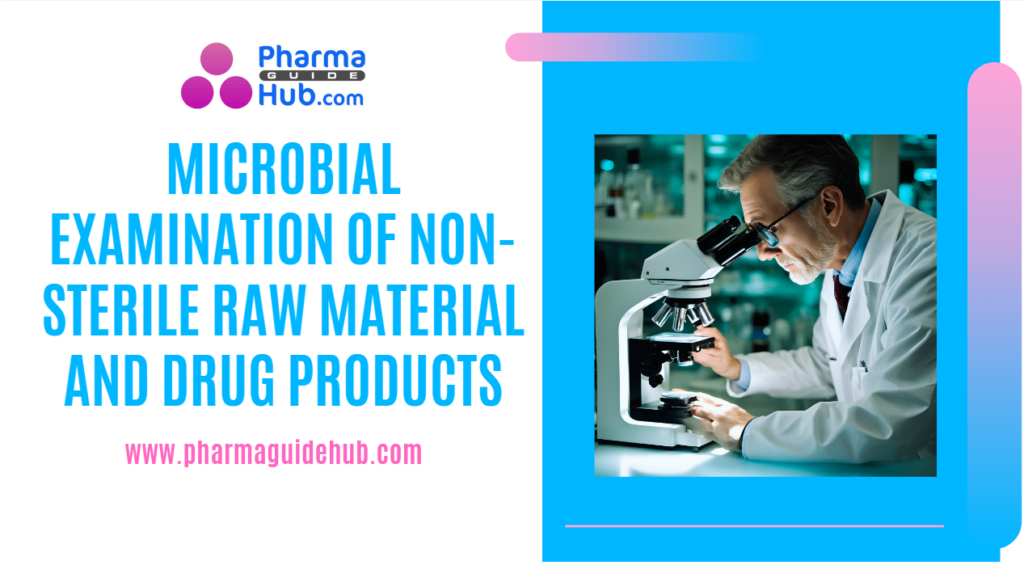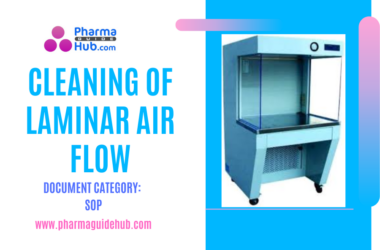
OBJECTIVE:
To lay down a procedure for microbial examination of non-sterile raw material and drug products.
SCOPE:
This SOP is applicable for the microbial examination of non-sterile raw material and drug products at {Company Name} {Location}.
RESPONSIBILITY:
In charge-Microbiology/ Head-Quality Control: for review and approval of SOP.
Microbiologist- to follow the procedure as per SOP.
ACCOUNTABILITY:
QA Head shall be Accountable for implementation of SOP.
PROCEDURE:
DEFINITIONS The definitions listed here apply in the context of this SOP and may or may not be applicable in all other usage.
Microbial Enumeration: Method for quantitative estimation of microbial load in the specimen, using specific microbiological culture media and incubation condition.
Mesophilic bacteria: A mesophilic bacteria is an organism that grows best in the moderate temperature, neither too hot nor too cold, typically between 20 and 45 °C (68 and 113 °F).
Principle:
The presence of certain microorganisms in non-sterile preparations has potential to reduce or even inactivate the therapeutic activity of the product and cause health hazard to the patient. Therefore, low bioburden of finished dosage form shall be ensured during the manufacturing, storage and distribution of non-sterile drug products.
Microbial examination of raw material and excipients used in non-sterile drug products shall be tested in accordance with the compendial test method.
The microbial enumeration test allows quantitative enumeration of mesophilic bacteria, fungi (yeast and mold) that grow under aerobic conditions.
The test for specified microorganisms determines the absence or limited occurrence of specified microorganisms that may be detected under the conditions described in compendial method.
Alternate microbiological procedures, including automated methods can be used, provided that their equivalence to the pharmacopeia method has been established.
Click the link to download word file copy of this document: https://pharmaguidehub.com/product/microbial-examination-of-non-sterile-raw-material-and-drug-products/
Methodology for Microbial enumeration test and test for specified micro-organisms:
The Microbial enumeration test and test for specified microorganisms determines, whether a substance or preparation complies with the established specification of microbiological quality.
Test Requirement
The microbial media used in enumeration test and test for specified microorganisms should be as per the compendia test chapters for microbial examination of non- sterile raw material and drug products.
The microbial media should meet the requirement of growth promotion, inhibitory and indicative properties as appropriate before use.
Tests should be carried out under the conditions designed, to avoid external microbial contamination of the product under examination.
Incase surface-active substances are used for sample preparation, their absence of toxicity for microorganisms and their compatibility with any inactivators used must be demonstrated.
In case of products having antimicrobial property, the antimicrobial activity should be neutralized using specified neutralization or inactivator system.
Efficacy and toxicity of such neutralizers shall be evaluated before use.
The method suitability study should be performed for establishing the ability of the test method to recover micro-organisms in the presence of product.
Sampling for raw material and finished product shall be carried out as per the site specific sampling procedure.
Samples for Microbiological analysis should be collected in airtight sterile container. The sample quantity collected should be sufficient to perform the test.
Sample preparation: Non sterile raw materials and drug products mainly categorized as water soluble, fatty and non fatty products insoluble in water, fluids or solids in aerosol form, and Transdermal patches.
Sample preparation shall be done by considering the above categories using specific diluents as specified in SOP.Product under examination (usually 10 g or 10 ml) shall be dissolved/suspend or rinsed with suitable diluent in the ratio of 1:10.
The dilution can be increased based on the characteristic of product, however ensure the dilution is not more than the specification limit recommended for the product/raw material being tested.
The sample quantity to be tested may be reduced for active substances that intended to formulated under following conditions
In case, amount per dosage unit is less than or equal to 1 mg or the amount per g or ml is less than 1 mg, the amount of sample to be tested is not less than the amount present in 10 dosage units of 10 g or 10 ml of the product.
In case of active substances where the sample quantity is limited or batch size is extremely small (e.g. less than 1000 ml or 1000 g), the amount tested shall be 1 % of the batch unless a lesser amount is prescribed or justified and authorized.
In case of products where the total number of entities in a batch is less than 200 (e.g. samples used in clinical trials), the sample size may be reduced to two units or one unit if the size is less than 100.
Microbial enumeration method: Microbial enumeration shall be performed either using pour plate method or membrane filtration method. The choice of method shall be based on the nature of the product and the required limit of microorganisms. The method chosen must allow testing of a sufficient sample size to judge compliance with the specification.
In case of pour plate method, appropriate quantities of prepared sample shall be inoculated in the sterile Petri plate followed by addition of molten agar and mixing in duplicate under aseptic conditions.
In membrane filtration method, appropriate quantities of prepared sample filtered through 0.45µm filter (type of filter may vary based on the characteristics of material or product) and rinsing of membrane using validated quantities of diluent followed by aseptic transfer of test membrane on the surface of pre-incubated agar media plates under aseptic conditions.
Sample plates shall be incubated at incubation conditions as specified in compendia chapter. Incubation times for microbiological tests of less than 3 days’ duration shall be expressed in hours. Tests longer than 72 hours’ duration shall be expressed in day.
A negative control shall be performed using the chosen diluent in place of the test preparation. There must be no growth of microorganisms. A failed negative control shall require an investigation.
Number of cfu per g/ml of the product shall be calculated by taking arithmetic mean of two plates and multiplying by dilution factor.
In case the sample quantity tested is less than the compendia recommendation, then the results shall be represented accordingly as per the quantity tested.
Click the link to download word file copy of this document: https://pharmaguidehub.com/product/microbial-examination-of-non-sterile-raw-material-and-drug-products/
Result interpretation:
Total aerobic microbial count (TAMC) shall be considered to be equal to the number of cfu found using Soyabean Casein Digest Agar. Colonies of fungi observed on the medium shall be counted as a part of the TAMC.
Total combined yeast/mould count (TYMC) shall be considered to be equal to the number of cfu found using Sabouraud Dextrose Agar. If colonies of bacteria observed on the medium shall be counted as a part of the TYMC. When the TYMC is expected to exceed the acceptance criterion due to the bacterial growth, Sabouraud Dextrose Agar containing antibiotics may be used.
Test for specified Microorganisms:
Test for specified Microorganisms shall be performed either using direct inoculation or by membrane filtration method. The choice of method shall be based on the nature of product and the required limit of microorganisms.
Number of specified Microorganisms to be tested varies based on the route of administration, and market requirement.
Test for specified Microorganisms shall be carried out as per the compendia method for Microbial examination of non-sterile drug products.
Test for each specified microorganisms should be continued up to selective/ differential agar identification even if no evidence of growth observed.
Observation of each step of the test should be taken after completion of the maximum incubation period.
Typical or atypical growth on the selective media should be confirmed by a suitable identification method which includes confirmatory tests and as well as manual /automated biochemical tests.
Identification and evaluation of test isolates:
In case of out of trend or out of specification result observed in microbial enumeration test, and/or growth having atypical characteristics observed on selective agar, morphologically different types of colonies shall be identified up to species level.
The isolated organisms shall be evaluated for its pathogenicity based on the review of the available published literatures and other appropriate references and guidances.
In case the isolate found is objectionable, the risk shall be evaluated based on the product characteristics, route of administration, and associated risk to the target user.
Out of trend/Out of specification resultsOut of trend (OOT) results –
Investigation shall be carried out for out of trend result. Identification shall be performed for Microorganisms isolated and risk shall be evaluated. Based on the investigation outcome, necessary CAPA shall be initiated, as appropriate.
Out of specification results–
Investigation shall be carried out as per site procedure for investigation. Based on the investigation outcome, necessary CAPA shall be initiated, as appropriate. Incase of raw materials, where appropriate, the investigations and the CAPAs shall be extended to the Vendors.
REFERENCES:
Not Applicable
ANNEXURES:
Not Applicable
ENCLOSURES: SOP Training Record.
DISTRIBUTION:
- Controlled Copy No. 01 : Head Quality Assurance
- Controlled Copy No. 02 : Head QC (Micro)
- Master Copy : Quality Assurance Department
ABBREVIATIONS:
| QC | : | Quality control |
| No. | : | Number |
| SOP | : | Standard Operating Procedure |
| EM | : | Environment Monitoring |
REVISION HISTORY:
CHANGE HISTORY LOG
| Revision No. | Details of Changes | Reason for Change | Effective Date |
| 00 | New SOP | Not Applicable | To Be Written Manual |
Click the link to download word file copy of this document: https://pharmaguidehub.com/product/microbial-examination-of-non-sterile-raw-material-and-drug-products/

